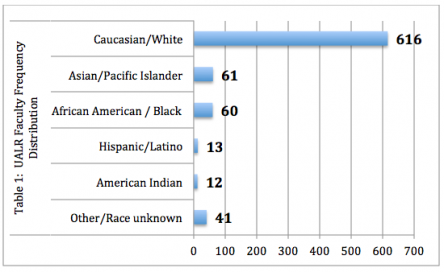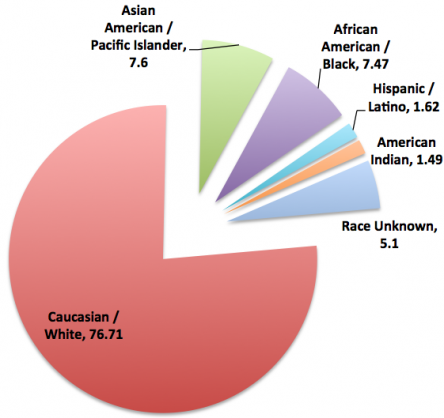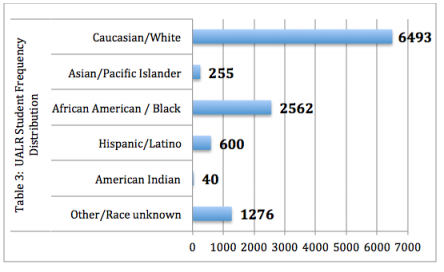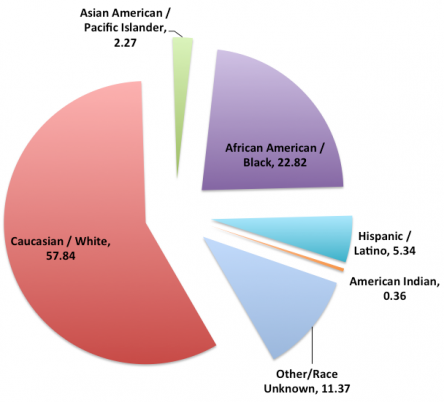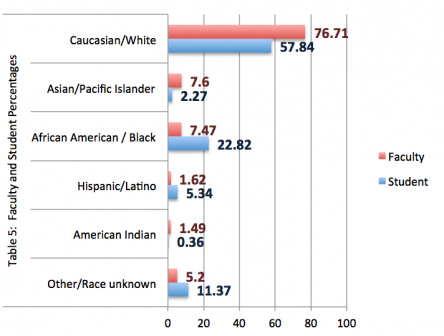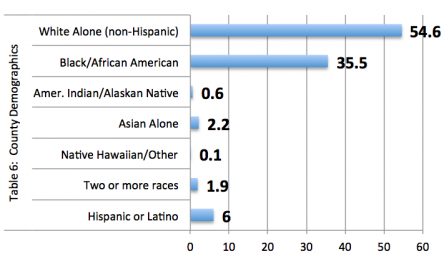The Numbers, Best Practices, and Recommendations
Prepared By: UA Little Rock Diversity Council | Dr. John Miller, Jr., Chair
May 8th 2014
Introduction
The University of Arkansas at Little Rock’s (UA Little Rock) Diversity Council was created in response to Goal 6 of the university’s strategic plan. The creators of the strategic plan sought to “hold the University of Arkansas at Little Rock accountable for becoming a diverse, multi-ethnic community characterized by an absence of institutional racism.” To answer this call, the Diversity Council has undertaken a major project each year to help move the campus forward in its diversity efforts. This year’s project was specifically devoted to understanding the institution’s current diverse faculty recruitment and retention efforts, to make recommendations for how they can be improved, to discover best practices from across the country, and to develop a plan for how to implement new ideas on the campus.
The decision to make this task our focus for this year’s report was in large part due to responses we received from the UA Little Rock Campus Diversity Survey that we commissioned the UA Little Rock/IOG Survey Research Center to conduct for us last year.
The purpose of this report is to: 1) assess the current level of racial and ethnic diversity among faculty, 2) assess current recruitment and retention efforts to attract and sustain a diverse faculty body, 3) examine best practices that can help with our recruitment and retention efforts, and 4) provide recommendations on how UA Little Rock can improve based on our findings.
Methodology
We divided our Council into two teams: Team A and Team B. Team A’s charge was to assess the current recruitment and retention efforts that are being done at UA Little Rock to hire and maintain a racially and ethnically diverse faculty. Additionally, Team A examined UA Little Rock’s current faculty racial and ethnic composition. Team B’s charge was to find out what the best practices are nationally with regard to the recruitment and retention of minority faculty. They also examined practices that institutions of higher learning are employing statewide and nationally.
Team A Report
By the Numbers [UA Little Rock Department of Human Resources]
UA Little Rock has total of 803 full time and part time faculty. As Figures 1 and 2 demonstrate, the majority of faculty identify as Caucasian/White followed by those who identify as Asian American/Pacific Islanders, African Americans, Hispanic/ Latinos, and American Indian. Approximately 5% of the faculty identify as another race or didn’t indicate their race when hired.
Table 1: UA Little Rock Faculty Frequency Distribution
Table 2: UA Little Rock Faculty Distribution by Percentage
The UA Little Rock student body currently has 11,226 students. As with the composition of the faculty, those who identify as Caucasian/White make the up the majority of the student body but represent a smaller percent of the student body. The percentage of students who identify as African American/Black is three times greater than the percentage of faculty who identify as African American/Black. The percent of students who identify as Hispanic/Latino, Asian/Pacific Islander, and American Indian is much smaller than the percent of faculty who identify with these groups while the percent of students who identify as other or did not identify their race is much greater than it is for faculty.
Table 3: UA Little Rock Student Frequency Distribution
Table 4: UA Little Rock Student Distribution by Percentage
Faculty and staff serve as key representatives of power structures within academic institutions. According to Edwards and Montague (2014), “Students are painfully aware when there is discrepancy in diversity between the faculty and student bodies on their campus, and failure to actively and publically pursue a more diverse faculty sends a message of insincere commitment to diversity.” Currently, there is a significant difference in the percentages of faculty of color comparative to students of color on campus. Table 5 visually shows this difference.
Table 5: UA Little Rock Faculty and Student Ratio Comparison
To fulfill the charge of their committee, Team A reached out to chairs of every department at UA Little Rock to conduct interviews to assess their departmental recruitment and retention protocol for minority hiring. In the months of February and March, 2014, the members of Team A (Sharon Downs, Eduardo Garcia, Hyginus Ukadike, Lakeshia Jones, Adjoa Aiyetoro, John Kuykendall, Sheri Tucker and Hassan Elsalloukh) contacted the chairs of the academic departments at UA Little Rock. The following is the script that each committee member followed:
The chancellor’s Diversity Council is focusing this year on the issue of recruiting more diverse faculty. I’d like to ask you a few questions to help the committee get a snapshot of where we are as a university on this important issue. Your specific responses will not be shared. Rather, we will pool all the responses and report back to our committee.
- What resources have you used to recruit faculty? Chronicle? Listservs? Which ones?
- Are there any resources that specifically target more diversity? If so, do you use them? If not, why not?
- Did you consult with HR to help in structuring the language and content in previous job advertisements, to help get a more diverse pool of applicants?
- Have you had a minority or diverse faculty applicant refuse an offer? If so, what was the reason given?
- What else would you like to share with the committee?
The Diversity Council will continue to gather more information on this important issue all year. We hope you don’t mind if we contact you again later this semester for a bit more information. Thanks for all you do!
Additionally, we reached out via email to the Chairs Council list to find out whether they had a diversity mentoring program, and to provide information if they did.
The following is a summary of the responses the committee received.
RESOURCES USED TO RECRUIT FACULTY
All respondents reported utilizing the Chronicle of Higher Education, and many indicated they advertised on the HR website. The next most-used sources (listed in order of popularity) are:
- Posting job announcements on professional listservs
- Posting job announcements on professional association websites
- Posting job announcements in professional publications
- Networking with colleagues around the country, including on professional boards and organizations
- Posting information at national conferences
- Advertizing in the Arkansas Democrat-Gazette
- Writing letters to every university with an accredited program in the relevant field.
Only a handful of respondents indicated they use only the Chronicle for advertising positions.
DIVERSITY-SPECIFIC RESOURCES UTILIZED
Most chairs indicated they work with HR and use the boilerplate language they are given. Many respondents indicated there are no diversity-specific resources to tap into, but they indicated they wished there were specific resources for recruiting diverse faculty. At least four chairs indicated they target specific organizations that focus on more diverse applicants and do so by:
- Contacting professional organizations were given that focus on diversity and include a focus on these populations:
- African-Americans
- Women and Minorities
- Hispanic/Latinos
- Writing personalized letters to all Historically Black Colleges and Universities (HBCUs) with accredited programs in his field.
DIVERSE APPLICANTS REFUSING AN OFFER
Three departments indicated they have experienced a diverse applicant refuse an offer and two said diverse applicants refused an interview due to finding better opportunities. Salary was the reason all applicants cited when they refused the interview or the hiring offer.
DIVERSITY MENTORING PROGRAM
There were no responses indicating any departments had a mentoring program specifically for minority faculty. However, four respondents said they do provide mentoring to new faculty. Two indicated each new faculty is paired with an existing faculty member for their first year, one indicated all new faculty are mentored based on need and one indicated they offer mentoring for all new faculty and it is tailored to the person.
COMMENTS FROM INTERVIEWEES
The following list contains some of the most compelling comments given by the chairs with whom the committee spoke:
- Diverse applicants are in high demand and are difficult to attract.
- Diverse applicants can pick and choose from their job offers because there are so many universities trying to recruit them.
- There is a general shortage of PhD candidates and this is especially true with more diverse potential applicants.
- One chair emphasizes need for diversity in advertisements.
- One department gives hiring preference to women, then to African-Americans, and then to those with 3 years of experience, in an effort to get out of the ‘good old boy’ system.
- One area indicated racial diversity has always been a factor considered in choosing the pool of candidates, although there is no written policy. However, a few years ago in a faculty meeting, diversity was listed as a factor to be considered in making hires.
- The pay at UA Little Rock is too low (this was repeated by several of the chairs).
- People don’t want to live in Arkansas.
- Diverse applicants don’t necessarily match the specialty required.
- In one field men are the minority, and so the chair got permission to change the requirement from a terminal degree to having extensive professional credentials just to attract more male applicants
- It is extremely difficult to hire minority in field of music because many African-Americans especially tend to go for professional degrees and not the arts.
- One chair said that UA Little Rock used to have policy (in the 1990’s) that if a department hires an African-American faculty to fill an existing position, they would get an additional position added; he indicated someone recently told him it was still a policy, but it was not an HR person.
Team B Report
Team B was lead by Brad Patterson. Other members included Christy Drale, Mindy Wirges, Harvell Howard, Michael R. Twyman, and Catherine Crisp. Their charge was to identify the best national practices for recruiting and retaining racial and ethnic minority faculty. They also examined practices that institutions of higher learning are employing statewide and nationally.
Recruitment
If UA Little Rock is going to have a faculty that is as diverse as the student body, the faculty, staff, and administration must commit to a strategy with specific metrics and a timeline in which to meet established goals. To do this, institutional personnel need data on underrepresented faculty PhD recipients by discipline in order to set realistic goals based on availability.
The Survey of Earned Doctorates is an annual census of “all individuals who received a research doctorate from an accredited U.S. institution in a given academic year.” The survey collects a broad range of demographic data that can be used to establish specific college and departmental targets for minority faculty hiring.
Once departments and colleges have established realistic goals for hiring diverse faculty, they will be better prepared to begin the search process for a new faculty member. Often, however, department personnel have limited experience with the process for recruiting diverse faculty. Dr. Christy Drale, Associate Vice Chancellor for Academic Affairs/Faculty Development and Administration, created a Diversity Hiring Best Practices document that can assist faculty search committees with the process.
Goal setting for diversity hiring and implementing best practices for search committees are significant steps in helping the university create an inclusive environment. There are many other examples from institutions across the country that may provide a roadmap as UA Little Rock works to improve its hiring for diverse faculty. The examples have been categorized by the best practices in Arkansas, from peer institutions, and from the leaders in diverse faculty recruitment.
Best Practices from Arkansas
There are several institutions in Arkansas that have made significant strides in increasing their percentage of underrepresented faculty. For example, the University of Central Arkansas (UCA) has a specific goal for minority faculty recruitment. Their goal is to “maintain the number (and corresponding percentage) of minority full-time faculty members of all ranks at UCA and to increase the numbers to the percentage of each race to approximately the percentage of degrees conferred by race nationally and masters degrees statewide.” To accomplish this goal the institution has established the following strategies:
- Continue to utilize the “Grow Your Own” concept, which identifies quality minority students who may be interested in completing graduate school with UCA’s help – with the agreement of returning to the university to teach afterwards.
- Continue the practice of providing a position to any college or department that can recruit a well-qualified minority.
- Establish relationships with graduate schools across the nation in hope of identifying minority graduates who are ABD and would like employment while completing their dissertations.
- Encourage utilization of the Faculty Development Program by faculty for the completion of terminal degrees.
- Invite minorities taking sabbatical leave from other institutions to assume residencies at UCA.
- Promote faculty exchanges with historically black institutions.
- Continue to advertise all faculty positions in national publications and in media that reach minority audiences.
The second in-state institution that can serve as an example for UA Little Rock’s efforts to improve minority faculty recruitment is the University of Arkansas for Medical Sciences (UAMS). UAMS has a Minority Faculty Development Caucus that is “designed to substantially increase and retain minority faculty…through networking, mentoring, research opportunities, and skill-building with a long-term goal of directly improving health care…”
Finally, Arkansas State University (ASU) has an extensive Minority Recruitment and Retention Plan that outlines their rationale and strategy for increasing the minority faculty and staff presence on campus. This plan outlines a “democratic rationale” for “embracing diversity as an integral component of academe and its pursuit of knowledge and excellence.”
Best Practices from Peer Institutions
In the UA Little Rock strategic plan, Fast Forward, there are 14 similar institutions that are used for comparisons on a number of metrics. Several of these institutions have exemplary models for diverse faculty recruitment that could be helpful for UA Little Rock:
- Georgia State University has an Office for Underrepresented Faculty that houses that policies and procedures for minority hiring at the institution. Interestingly, the office is not staffed by full time personnel but rather by faculty who have 25% appointments for the academic year.
- UMASS-Boston publishes a diversity brochure that is targeted to potential applicants.The brochure highlights the institution’s efforts to create a warm and welcoming environment for faculty from all backgrounds.
- UNC-Charlotte has an Office of Faculty Affairs and Diversity that is specifically devoted to building “faculty diversity and success through research and programming on recruitment, re-appointment, promotion, and tenure practices: policy reform; mentoring; leadership and career development.”
Best Practices from Across the U.S.
In addition to the examples from Arkansas and from peer institutions, there are a number of best practices from across the country that can assist in the development of UA Little Rock efforts to recruit diverse faculty.
For instance, Western Washington University has an extensive plan for recruitment and retention and a Vice Provost for Equal Opportunity and Employment Diversity.
The University of California-Los Angeles has an Office for Diversity and Faculty Development that serves as a resource for colleges and universities across the country who are seeking to improve their diverse faculty recruitment.
Retention
UA Little Rock currently has nothing in place for underrepresented faculty retention. This means that even if faculty from underrepresented groups are hired, they often have little support to assist them in navigating the tenure and promotion process. Most of the institutions listed as best practices for diverse faculty recruitment either have a faculty mentoring program or have listed the creation of a program as one of their goals.
Analysis
While many conclusions can be drawn from this preliminary data, we offer a few observations and welcome more from the campus community:
- Some departments depend solely on the Chronicle of Higher Education. It seems that some collaboration with departments to determine other sources of good applicants would be helpful, such as exploring professional listservs, which costs nothing.
- The salaries at UA Little Rock contribute to the difficulties in hiring diverse faculty. It is unknown how much this is impacting the hiring of faculty in general.
- There was some creativity in how some departments approach recruitment of diverse faculty. Particularly impressive was the one chair who wrote personalized letters to every HBCU who had a program in his field.
Recommendations
Based on our review of the data at UA Little Rock and practices at other institutions in Arkansas and throughout the country, the Diversity Council recommends that UA Little Rock commit to the following in order to increase recruitment and retention of faculty who are racial and ethnic minorities:
- Post the document Diversity Hiring Best Practices on the Diversity Council website.
- Work with the Department of Human Resources to distribute the Diversity Hiring Best Practices to every department when they are approved for a new faculty line.
- Establish college and departmental goals for underrepresented faculty hiring based on recent PhD recipients in each academic concentration.
- Create a recruitment brochure that targets underrepresented groups for faculty positions (Diversity Council potential project).
- Create or facilitate a campus-wide robust faculty mentoring program.
- Create an office that is dedicated to underrepresented faculty recruitment and retention.
Concluding Thoughts
As mentioned at the beginning of this report, UA Little Rock’s faculty numbers should more closely mirror the student demographics of our campus (see Table 5). In order to reach our strategic goal of substantially increasing our student body, we should increase our recruitment and retention of racial and ethnic minority faculty. The suggestions made by our Council in this report are good places to begin with increasing our efforts in the area. A long range goal that UA Little Rock may want to consider pursuing is to attempt to make our campus community more representative of the racial and ethnic demographics of Central Arkansas. As demonstrated in Table 6 below, UA Little Rock’s current racial and ethnic minority faculty representation is not representative of Pulaski County where we are located. As a metropolitan school who celebrates and values the richness of our central location in the state, as well as our proximity to all of the rich resources that our region has, a more diverse campus from the administrative, faculty, staff, and student levels could serve our institution well. As we look out into our local community, state, and nation, a more diverse faculty body will help UA Little Rock recruit more students and qualified scholars to add to our already diverse and robust community.
Table 6: Pulaski County Demographics
Mentoring programs are necessary to help retain minority faculty once they are hired. Research shows that mentoring can be beneficial for all faculty, but specifically for minority faculty who strive to navigate the ranks from assistant to full professor. In addition to the recommendations brought forth in this report, individual departmental mentoring programs or national programs such as the National Center for Faculty Development and Diversity are good resources that can be tapped into to provide the campus with our needs. Many of the chairs we interviewed stressed that more resources are needed for individual departments when determining how to better recruit and retain a more diverse faculty. Resources such as the Diversity Hiring Best Practices as well as the creation of a central online location for all members of the UA Little Rock community to access should be made available to all faculty.
In closing, the Diversity Council believes that diversity must be something that is not simply discussed but actively pursued. For UA Little Rock to ultimately achieve our diversity goals, respecting and valuing diversity and inclusion must be a non-negotiable aspect of being a member of our campus community. This report, along with other resources will be made available at our website for all members of the UA Little Rock community to use.
References
Edwards, T. & Montague, D.R. (2014). The university’s role in advancing race relations: Reflections from the community. Coalition of Urban and Metropolitan Universities (CUMU) Journal.
United States Census Bureau (2012). Pulaski county, Arkansas people quick facts [Data File]. Retrieved from http://quickfacts.census.gov/qfd/states/05/05119.html
University of Arkansas at Little Rock Department of Human Resources (2013). EEOC data block report. Retrieved December 16, 2013.
